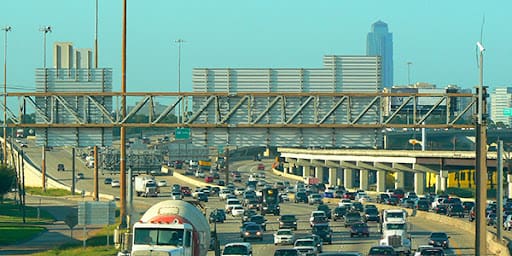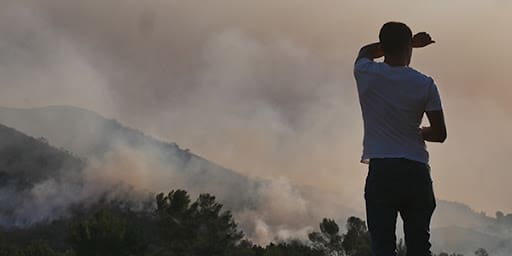As one of the top-ranked areas for ozone, particle pollution, and toxic air releases, the Houston region is no stranger to air quality concerns. Here you’ll find information about air pollution and what you can do to reduce your exposure.
What is Air Pollution?
Some pollutants may be both primary and secondary. Formaldehyde, for instance, may be emitted directly from a source and may also be formed by secondary reactions of certain hydrocarbons.
Primary Pollutants
Primary pollutants are substances emitted directly from a source, such as the carbon monoxide gas from a motor vehicle exhaust or sulfur dioxide released from factories.
Secondary Pollutants
Secondary pollutants form when primary pollutants react in the atmosphere. For example, ground-level ozone is created when hydrocarbons (HC) and nitrogen oxides (NOx) combine in sunlight.
What Are the Sources of Air Pollution?

Mobile
Mobile sources are vehicles used in all modes of transport, including cars, trucks, trains, ships and planes. While fossil fuel combustion is the major culprit of mobile source air pollution, tire and brake pad wear is also a significant source of mobile emissions.

Stationary
There are two types of stationary air pollution sources:
- Major stationary sources are defined as sources that emit 10 tons per year of any of EPA controlled toxic air pollutants, or 25 tons per year of a mixture of air toxics. These sources include industrial facilities like chemical plants, steel mills, oil refineries, power plants, and hazardous waste incinerators.
- Stationary area sources consist of smaller-size facilities (e.g. metal recycling facilities, concrete batch plants, dry cleaners, gas stations) that release lesser quantities of toxic pollutants into the air. Collectively the emissions from these sources can be of concern – especially in heavily populated areas. The category also includes agricultural areas.

Natural
Natural sources are naturally occurring events which cause air pollution and include dust storms, wildfires, and volcanic eruptions. The occurrence of these events is becoming more common with climate change, which heightens their impact on air quality. While outdoor air pollution originates from both natural and man-made sources, the contribution from human activities far exceeds natural sources.

Indoor
Indoor sources include building materials, a range of household goods and gas-powered appliances. Inadequate ventilation, high temperatures and humidity levels can increase indoor pollutant levels. Air Alliance Houston does not currently focus on indoor air pollution but recognizes its importance to public health.
Indoor sources include building materials, a range of household goods and gas-powered appliances. Inadequate ventilation, high temperatures and humidity levels can increase indoor pollutant levels. Air Alliance Houston does not currently focus on indoor air pollution but recognizes its importance to public health.
Learn about indoor air-purifying plants in our dual-language flyer.
Daily Safety Tips
Until air pollution is stopped at source, minimize your exposure with these simple actions:
Check daily air pollution forecasts in your area. Sources include local radio and TV weather reports, newspapers and online at airnow.gov.
If you have asthma, use your preventer inhaler regularly.
Avoid exercising or spending long periods of time near busy roads, even when air quality forecasts are green.
If you walk, run, or cycle, avoid congested roads and use side street routes instead.
Try to commute a little earlier because air pollution builds up during rush hour.
Reduce or avoid strenuous outdoor exercise when air pollution levels are high, especially if you have a lung condition such as asthma, or do your exercise inside. Children should limit the time spent playing outdoors if the air quality is unhealthy.
Regulation in the U.S. and Texas
The Clean Air Act is a US federal law designed to protect human health and the environment from harmful air pollution caused by a diverse array of pollution sources.
The Texas Commission on Environmental Quality (TCEQ) is the agency assigned to enforce the Clean Air Act in Texas. However, the TCEQ’s enforcement record leaves much to be desired: A recent investigation by the Environmental Integrity Project found that the TCEQ issued penalties for less than 3 percent of unauthorized air pollution releases from 2011 to 2016.
While the Houston area has never met the air quality standards set for ozone, the Clean Air Act has driven air quality improvements nationally for nearly 50 years, preventing hundreds of thousands of cases of serious health effects each year.


